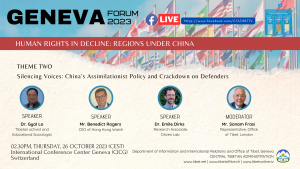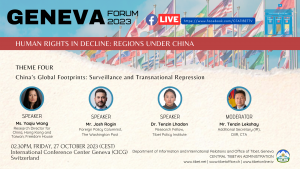The government of the People’s Republic of China’s (PRC) development policies in Tibet and regions under its illegal occupation have been guided from the start by the political and strategic logics of bringing the regions under its strict control and to exploit its rich and untapped natural resources. Beijing boasts each time it issues a white paper about Tibet’s rapid development of roads, railways, and airports, a cunning tactic used to cover up egregious abuses of human rights in its colonized territories. The infrastructure development primarily benefits the Chinese military deployment in Tibet, as well as Chinese workers and residents migrating to Tibet, which, given the increasing influence of China, has grotesquely undermined the unique Tibetan identity of languages and cultural practices.
The rapid development of infrastructure in Tibet, as well as the extravagant budget set aside for development in China’s previous “Five-Year Plans”, intends to assimilate the Tibetan people and legitimize China’s illegal rule. China’s large-scale infrastructure projects in Tibet primarily serve political and economic interests, especially amid rising border tensions with India. The Sichuan-Tibet Railway, though promoted as development infrastructure, plays a strategically vital role in facilitating the swift transportation of military personnel, materials, and logistical supplies, ultimately strengthening the military presence of the region to control the Tibetans and enhancing border stability. Such infrastructure also boosts tourism generating state revenue while marginalizing Tibetans and their linguistics and cultural expression and expedites the resource exploitation, extraction, and transport to China, rather than genuinely benefiting the Tibetan people. An early piece of evidence appears in Hu Yaobang’s statement following his visit to Lhasa in 1980 and finding that Tibetans had benefited nothing from Chinese financial assistance. In public, he described it as “plain colonialism” and questioned Chinese officials about where the assistance from China had been used. China’s construction of border villages is another pretentious project to the detriment of Tibetans and is intended to attract Tibetans to live in these border defense villages and serve as their ears and eyes when the Chinese army expands and secures its borders in the Himalayas.
Xi Jinping emphasized prosperity and high-quality development in Tibet, but evidence suggests a discrepancy between these goals and the realities faced by Tibetans. This evidence includes forced labor, arbitrary detention in alleged forced concentration camps, involuntary DNA collection, and mandatory enrollment in boarding schools. The extensive restrictions imposed on Tibetans violating their fundamental freedoms and rights, contradict the PRC government’s claim of fostering development and welfare of the Tibetan people. This can be seen in how China plans and executes its initiatives in Tibet and other regions for education, poverty alleviation, employment, and environmental preservation.
Assimilationist Education Policies
Local languages are poorly safeguarded in practice and have instead been the primary target of state sinicization campaigns in the last decade. In Tibet, Tibetan language education has gradually been phased out at primary and secondary level schooling in favor of a Chinese-medium instruction model. At least 70 percent of all schools across Tibet now use Chinese medium instruction, and all schools within the “TAR” have already completed the shift. The PRC government is implementing a number of initiatives, such as closing schools using Tibetan educational materials; banning materials that reference Tibetan Buddhism, identity, and history; and replacing village schools with colonial boarding schools across Tibet, where children are separated from their families from the age of four and lose their sense of belonging and identity.
Southern Mongolia’s Education Department announced on 26 August 2020 that language classes for first-year students in elementary and middle schools will be taught in Mandarin using national textbooks. The policy has sparked fears that Mongolian culture and identity may be adversely affected, resulting in protests and strikes across the region.
“Poverty Alleviation Campaigns” and Resettlement
China’s nomad settlement policy, often cited as a case exemplifying poverty alleviation and development, is in fact a counter example of poverty alleviation. In Tibet, Tibetans are compelled to agree to resettlement since doing otherwise would subject them to persecution and harsh punishment. Under various Chinese policies, more than 2 million nomadic populations have been settled into sedentary homes since the 1980s. Moreover, over half a million Tibetans are being subjected to coercive labor training with enforced indoctrination, intrusive surveillance, military-style enforcements and harsh punishments. The Chinese government deprived Tibetans of their livelihood by grabbing agricultural land and forcing Tibetan nomads to relocate. Meanwhile, China is rounding up Tibetans into labor camps and factories for absolute subjugation under the name of ‘poverty alleviation’ and ‘development’. Therefore, Tibetan rural communities suffer deterioration in their quality of life, as well as their peaceful and harmonious relationship with Tibet’s wildlife and environment.
In East Turkestan, forced labor is described as an important component of Chinese government plans for the region’s economic development, particularly in textile and apparel manufacturing. The so-called poverty alleviation drive in East Turkestan, while constituting employment of more than half a million Uyghurs in State “vocational internment camps”, is actually intended to complete Uyghur assimilation through coercive labor, weaponized education, and intergenerational separation. For instance, a study by the Australian Strategic Policy Institute (ASPI) estimates that 80 thousand Uyghurs were deported from 2017 to 2020 to factories throughout China due to forced labor.
Marginalized Employment Policies
Tibetans have linguistic, educational, and cultural disadvantages in the job market due to the Han-dominated and Han-defined labor market. The promise of the authorities to create more jobs for Tibetan graduates has fallen short over the years, with a continuous flow of Chinese migrants resettling in Tibet in the name of development. Almost all professional jobs are still offered to Chinese, therefore Tibetans have difficulty finding employment. In the public sector, the Chinese government imposes biased eligibility criteria and preconditions on Tibetans who are seeking jobs, including “criticizing the Dalai Lama”, refraining from “separatist activities”, and cutting ties with Tibetans residing outside Tibet. Requirement for Tibetans to meet political qualifications to find jobs shows the Chinese government’s sense of deep insecurity and underscores its priority in Tibet is political correctness, with anyone who does not follow the official Chinese policy line having no chance of getting a job. In April 2023, a group of six UN experts expressed concerns about China’s vocational training and forced labor programs in Tibet and found it to be eroding Tibetan identity, enforcing surveillance and political indoctrination, and potentially leading to coerced labor. Since 2015, hundreds of thousands of Tibetans have been coerced into low skilled, low-paid employment, despite the program being described as voluntary. As China seeks to promote Chinese culture and language dominance in Tibetan areas, the requirement for proficiency in Mandarin Chinese in testing and employment consideration has disadvantaged Tibetan students.
Environmental Destruction
China’s “development” policies in Tibet are carried out without environmental assessment and consultation with the local community. China is increasingly building dams across Tibet’s transboundary rivers, potentially impacting over 1.8 billion people in the countries downstream, while scientists predict that temperatures on the Tibetan plateau will rise by 4.6 degrees Celsius by the end of this century. With China’s aim to meet its targets of achieving carbon neutrality by 2060, the Chinese Government amidst the pandemic announced its plans to build a hydropower plant that could generate three times as much power as Three Gorges at the lower reaches of the Yarlung Tsangpo—a transboundary river that flows from Tibet into India and Bangladesh. The announcement came as part of the government’s 14th five-year plan, a series of guidelines spelling out China’s economic and social priorities.
China’s occupation of Tibet and its control over Tibet’s land and natural resources has caused significant degradation of the environment and ecosystem in Tibet. This includes industrial projects such as unregulated and reckless mining, damming and deforestation. With China’s repressive policies, Tibetan don’t hold any agency in stewardship of their land and the few voices of Tibetan environmentalists and climate activists are silenced with detainment and decades-long imprisonment. The effects of these changes are becoming more evident in the form of melting glaciers, intensified weather events, increasing desertification, and degraded grasslands. In 2023, Tibetan farmers in seven villages in Rebkong, Amdo were forced to vacate their land and only ten days of notice was issued to uproot from their ancestral land for the construction of a hydropower dam. Earlier this year, 10 Tibetans were imprisoned in Sangchu in Amdo for resisting similar orders.
Conclusion
Up to 1 million Tibetan children are forcibly sent to boarding schools where they are systematically cut off from their language and culture. Up to 2 million Tibetan farmers, nomads, and other rural populations have been forcibly relocated in recent years. Tibetans who peacefully disagree with Chinese policies are subjected to persecution and severe government interference in their right to practice their faith. The PRC government has consistently denied accusations that it has implemented harsh tactics to assimilate the Uighur population and force them to adopt CCP ideas and give up their identity, including their language and culture. As a result, forced labor is still widespread in East Turkestan. China recently released guidelines to encourage the security and high-quality development of Southern Mongolia, with the goal of enhancing the region’s capabilities to protect China’s industrial, food, energy, and border security. It is evident and established that China’s “development” policy in the regions it illegally occupies is based mostly on its inability to assert total control and serves as a guise to cover up its brutal exploitation of these regions to the world.
The widespread discontent among the Tibetans and other colonized peoples under the PRC along with the government’s heavy reliance on repressive tactics underscores the limitations of conventional metrics of living standards to determine development in Tibet. The current situation of Tibetans, marked by poverty and social inequalities, stem from a seven decades-long campaign of enforced assimilation into China’s nation-building project, persistently marginalizing the Tibetan people within their ancestral territory. China has consistently misled and disregarded the international community by continuing to shun accountability for its atrocities and instead trumpets its development narrative.


